#Académie des beaux arts de Liège
Text
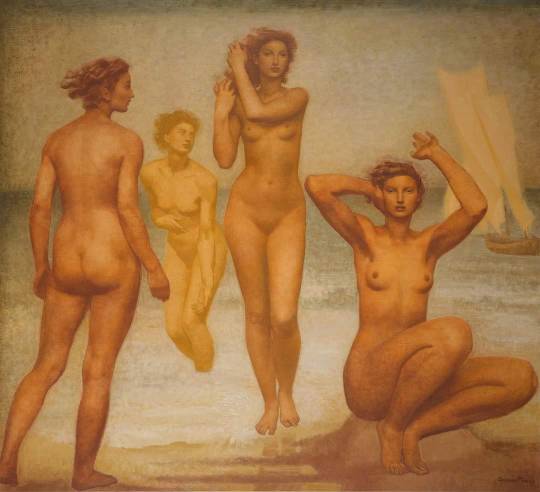
Suzanne Fabry (Belgian painter) 1904 - 1985
Female Nudes by the Sea, 1943
oil on canvas
157 x 173 cm. (61.75 x 68 in.)
signed and dated Suzanne Fabry/ 1943 (lower right)
private collection
© photo Sotheby's
Catalogue Note Sotheby's
Born in Brussels in 1904, Suzanne Fabry was the daughter of the Belgian symbolist painter Émile Fabry (1865–1966) and his wife Virginie Duchênes. Her brother, Barthélémy, was born in 1898. Three years before Suzanne’s birth, her father was named Professor of Drawing at the l’Académie Royale des Beaux-Arts de Bruxelles, where he had been a student in the 1880s, and her childhood was spent in his house-studio at rue Verte (today rue du Collège Saint-Michel, n°6) in Woluwe-Saint-Pierre, a south-eastern neighborhood of Brussels.
At the start of World War I, Suzanne moved with her family to England where they remained until the end of the war, first in Herefordshire and later in the Cornish town of Saint-Ives. They returned to their home in Belgium after the war and in 1923 Suzanne enrolled as a student at the Académie Royale des Beaux-Arts where she studied under Jean Delville (1867-1953) and Constant Montald (1862-1944), two of the founders, alongside her father, of a group of artists who called themselves “L'art monumental.” The group’s aim was to produce public, monumental, and culturally sophisticated art that would elevate the public consciousness through the representation of idealized universal themes. Their commanding nudes would constitute an important source of inspiration for Suzanne’s own work.
Suzanne graduated from the Académie in 1928 and embarked on her career as a painter in the 1930s, taking part in the triennial Salon in Antwerp (1930) and the quadrennial Salon in Liège (1931). Around the same time, her father was completing a cycle of large-scale paintings for the entrance and staircase of Brussels’ opera house, La Monnaie, where, many years later, Suzanne and her husband Edmond Delescluze (1905-1993) would be employed as costume and set designer respectively, a collaboration that began in 1948 and is recorded in over 900 sketches and stage maquettes preserved today in the archives of La Monnaie. She continued to pursue her career as a painter, alongside her work as head of the opera’s costume workshop, until her death in 1985.
In this monumental multi-figure composition, painted in 1943, Fabry adapted the solidity, scale, and style favored by the Symbolist painters of her father’s generation to a defiantly modern feminine subject. Fabry perfected her own brand of pointillism, establishing the pale blue background in broad loosely layered brushstrokes against which the four figures are sharply defined in saturated ochre tones. The palette and composition–statuesque theatrically posed figures arranged across a picture plane–ehcoing her father’s work, notably Maternity (1923) and Towards the Unknown, for which Suzanne posed and was photographed as aide memoires (see Jacqueline Guisset, Emile Fabry, 2000).
These photographs, and the studio practice they elucidate, suggest the context in which Suzanne developed her own working methods and artistic style. Suzanne’s four figures are arguably full-length self-portraits–with idealized features resembling the artist’s own, looking to her self-portrait with paintbrush in hand (1932) –making the composition a triumphant declaration of her artistic identity as both creator and muse.
The central figure’s pose recalls Botticelli’s iconic Birth of Venus, recasting the Renaissance goddess in a personal and fiercely modern mode. Rather than covering herself, Fabry’s figure reaches up to her auburn hair, staring straight at the viewer and seemingly strides forward, trading Botticelli’s stationary feigned modesty for confidence in motion. Impastoed splashes of water at her feet evoke Venus’s outsized shell in a more realistic and yet abstract reference perhaps to her own rebirth as an artist.
Fabry returned to the female nude the following year in a large-scale single-figure representation of a woman–perhaps herself–called L’Attente (1944), exhibited at the Salon de printemps that year. Holding an amphora above her head with two hands against a distant background of ancient ruins, the figure stands tall, matching the height of the doric column behind her, as a pillar of strength and fortitude, peering fearlessly ahead, her weight shifted to the front of her toes as if to leap forward.
Female Nudes by the Sea is an important rediscovery within the oeuvre of Suzanne Fabry, and the 20th-century Symbolist movement. In this multi-figure self-portrait, Fabry audaciously contends with her artistic heritage and asserts her own distinctive identity and aesthetic.
* * *
Born in Brussels in 1904, Suzanne Fabry was the daughter of the Belgian symbolist painter Émile Fabry (1865–1966) and his wife Virginie Duchênes. Her brother, Barthélémy, was born in 1898. Three years before Suzanne’s birth, her father was named Professor of Drawing at the l’Académie Royale des Beaux-Arts de Bruxelles, where he had been a student in the 1880s, and her childhood was spent in his house-studio at rue Verte (today rue du Collège Saint-Michel, n°6) in Woluwe-Saint-Pierre, a south-eastern neighbourhood of Brussels of recent urbanisation.
At the start of the First World War, Émile Fabry moved with his family to England, first staying in Herefordshire and later in the Cornish town of Saint-Ives, where he would continue to paint, and they would remain until the end of the conflict. Back in Brussels, the family returned to their home on rue Verte, and in 1923 Suzanne enrolled as a student at the Académie Royale des Beaux-Arts, where her teachers included Jean Delville (1867-1953) and Constant Montald (1862-1944), two of the founders, alongside Suzanne’s father, of the group “L'art monumental”. Their aim was to produce art for the public sphere, monumental in scale and steeped within the cultural tradition of the period, intended to elevate the public conscience by means of representing idealised, universal themes. Their commanding nudes would constitute an important source of inspiration for Suzanne’s own work.
Having graduated from the Académie in 1928, Suzanne began her career as a painter in the 1930s, taking part in the triennial Salon in Antwerp (1930) and the quadrennial Salon in Liège (1931). Around the same time, her father was completing a cycle of large-scale paintings for the entrance and staircase of Brussels’ opera house, La Monnaie, where, many years later, Suzanne and her husband Edmond Delescluze (1905-1993) would be employed as costume and set designer respectively, a collaboration that began in 1948 and is recorded in over 900 sketches and stage maquettes preserved today in the archives of La Monnaie. She continued to pursue her career as a painter, alongside her work as head of the opera’s costume workshop, until her death in 1985.
Source: Ambrose Naumann Fine Art
18 notes
·
View notes
Photo
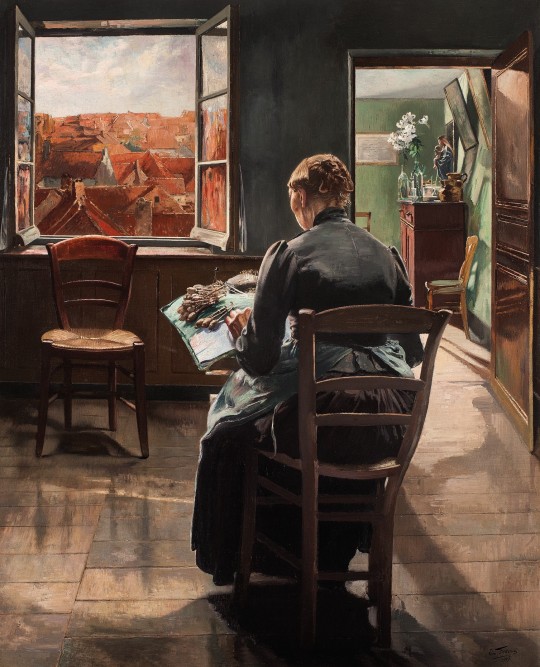
The Flemish Lace Maker, La dentellière flamande by Léon Frédéric, 1907
"I have always been moved by silence represented in paintings throughout history, from Vermeer’s interiors depicting a lone woman bathed in light and Jacobus Vrel’s empty street scenes, to the quiet beauty of Hammershoi’s silent rooms, and this painting by Leon Frederic is such a work. It depicts a Flemish woman quietly working in an interior with a townscape beyond, and the light that illuminates the flowers and the wall on the right side is particularly striking."
George Wachter
Léon Frédéric drew on contemporary and earlier influences as well as on his own personal spiritual views of life and nature to evolve a unique artistic style. Working during a period when Impressionism and its offspring Divisionism and Post-Impressionism were the main currents of avant-garde art, Frédéric’s idiosyncratic realism comes as a considerable surprise. Frédéric studied briefly under Charle-Albert before attending the Académie Royal des Beaux-Arts in Brussels, where he became a pupil of Jules Vankeirsblick (1833-96) and Ernest Slingeneyer (1820-94). He also worked in the studio of Jean-François Portaels (1818-1895).
The tenor of Frédéric’s work was formed largely by the Italian and Flemish art of the fifteenth and sixteenth centuries, and the poetic paintings of the English Pre-Raphaelites. A two-year sojourn in Italy (1876-78) which included visits to Venice, Florence, Naples and Rome, exposed Frédéric to the works of the Italian Renaissance. This experience conveyed to the painter the profound beauty of nature with its artistic disposition toward harmony, and the inherent nobility of mankind. This sense of harmony was balanced by a personal artistic vision which conveyed a truthfulness to nature which was reinforced by Flemish, Dutch and German Old Master painters who had directly studied their natural surroundings. Both Italian and Northern Renaissance schools depicted the natural world through clear, detailed compositions, and their influence infuses Frédéric’s work with a lucid and unaffected honesty. In his symbolist designs, including his various large multi-paneled Cycles of Life, Frédéric attempts to unify Christian mysticism with the current social conditions of the working class. The landscapes included in many of these compositions take delight in a pantheistic communion with nature.
Following his stay in Rome, Frédéric made his debut at the Brussels Salon in 1878. He then became a member of the Brussels-based association L’Essor, a group of young artists who wanted to paint contemporary social reality instead of using imaginary or literary themes as their artistic starting point. Subsequently, his work was exhibited in Ghent, Liège, Munich, Nice and Paris. He was awarded gold medals for painting at the Exposition Universelle of 1889 and 1900, and in 1929, together with James Ensor, Frédéric was created a baron.
Many of Frédéric’s early works show poor people and peasants, especially after 1883, when the artist moved from Brussels to Nafraiture, a small village in the Ardennes region of Belgium where he lived for several years.
At first glance, the present realistic composition seems quite straightforward. The painting’s quiet intimacy draws the viewer in to a spare interior, where an elderly lace maker bends over her work, bobbins and pins before her. However, the subject matter and informal composition are rendered equivocal by this monumental woman, mysteriously turned away from us. The mood and manner is quiet, and time seems to hang suspended. The lace maker, dressed in black, but wearing a blue work apron, seems to live alone, but an empty chair faces her, set beneath the open window. This chair exactly mirrors her own, and is a portrait of absence. The simple room displays an exquisite symphony of light. The watery reflection on the polished floor, the dappled light and shadows in the distant bedroom, the bright stalk of Madonna Lilies set in a simple glass bottle before a life-like statue of the Virgin and Child, all help suggest a strong sense of three-dimensional space. Perhaps the most striking passage of this contemplative work is the jumble of red-tiled roofs viewed from the open window. Their bright color and chaotic arrangement are in striking juxtaposition to the neat, quiet interior dominated by the silent concentration and downward gaze of the lace maker, her expression inscrutable to the viewer.
Spinning, weaving, and needlework of all kinds have, since biblical days, been seen as activities associated with feminine virtue. The book of Proverbs (31: 10-13), for instance, in a section which contains the lines “Who can find a virtuous woman? For her price is far above rubies,” goes on to say: “She seeketh wool, and flax, and worketh willingly with her hands.” In the Odyssey, to cite a classical, example, Penelope puts off her anxious suitors, while awaiting Ulysses’ return, by weaving by day and unraveling her work by night. Perhaps Frederic here portrays industriousness as a symbol of domestic virtue, a theme bolstered by the inclusion of the lilies and the statue of the Virgin Mary, all bathed in radiant light on this warm spring or summer day.
Léon Frédéric certainly would have been familiar with the long artistic tradition of depicting the subject of lacemaking. The theme was particularly popular in the Seventeen century and was frequently portrayed by Dutch artists such as Johannes Vermeer, Pieter de Hooch, and Nicolas Maes.
24 notes
·
View notes
Photo


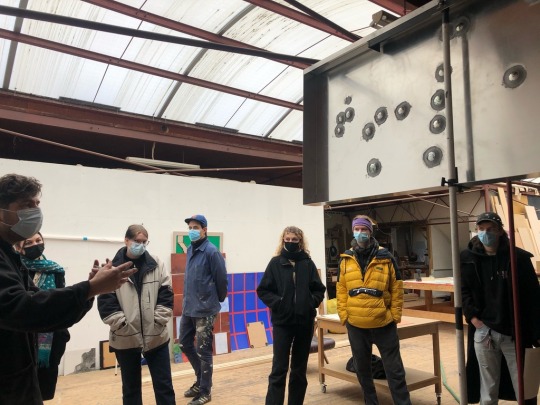
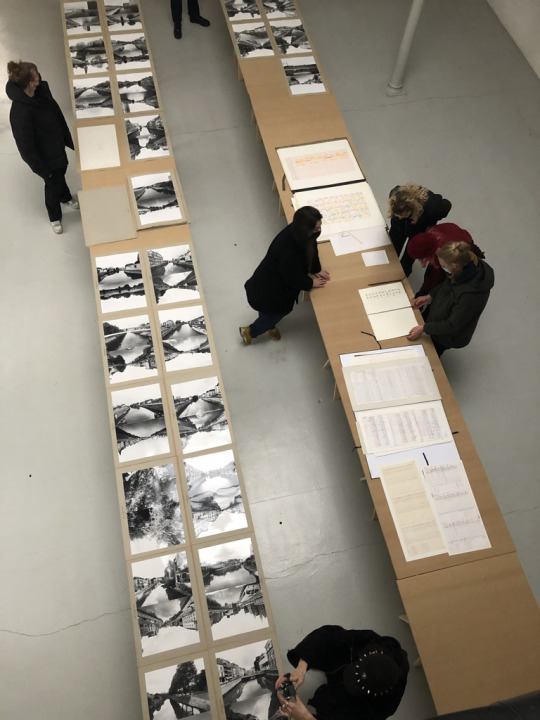
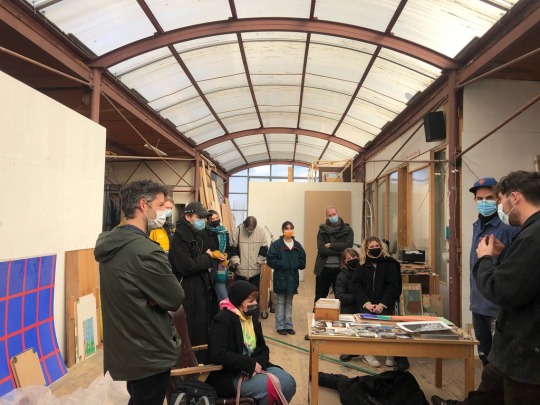
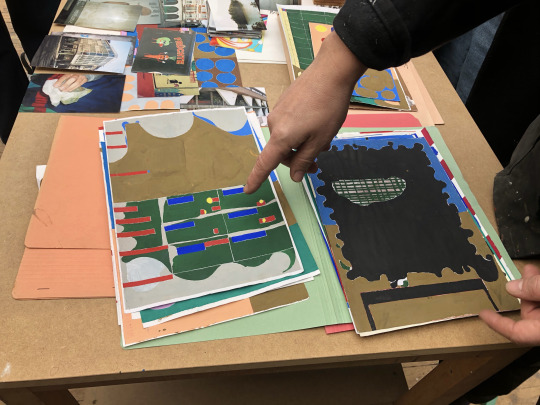
Driedaagse in Luik, op bezoek bij Manuel Falcata en Jeôme Devige (voormalig Pica Pica), Cleo Totti, Jacques Charlier, galerie Nadja Vilenne, Les Brasseurs, Académie des Beaux-Arts Liège
0 notes
Photo

For thé first time, I think, I show u an oil painting I made when I was student at the academy of fine arts in Liège , twenty years ago. I painted this view of my town from the roof of the house I rent with four friends.. This one is still on the wall at my father ;) . . . . . . . #oilpainting #studentpainting #oilpaint #view #viewfromroof #90s #academyoffinearts #liege #student #firststeps #oilcolorpainting #impressionism #artwork #kunst (à Académie Royale des Beaux-Arts de Liège)
#academyoffinearts#impressionism#kunst#viewfromroof#studentpainting#firststeps#view#liege#90s#oilpaint#oilpainting#oilcolorpainting#artwork#student
5 notes
·
View notes
Photo
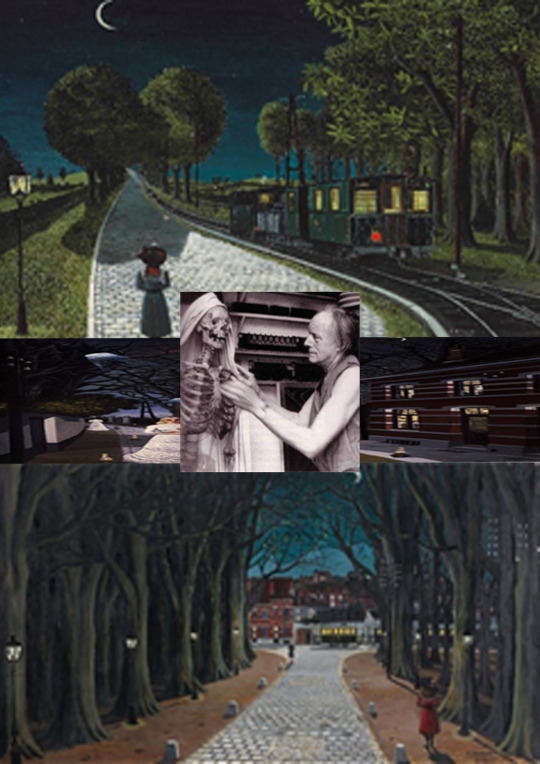
Paul Delvaux
Paul Delvaux was a Belgian painter noted for his dream-like scenes of women, classical architecture, trains and train stations, and skeletons, often in combination.
He is often considered a surrealist, although he only briefly identified with the Surrealist movement.
Delvaux was born in Wanze in the Belgian province of Liège, the son of a lawyer.
The young Delvaux took music lessons, studied Greek and Latin, and absorbed the fiction of Jules Verne and the poetry of Homer.
All of his work was to be influenced by these readings, starting with his earliest drawings showing mythological scenes.
He studied at the Académie Royale des Beaux-Arts in Brussels, albeit in the architecture department owing to his parents' disapproval of his ambition to be a painter.
Nevertheless, he pursued his goal, attending painting classes taught by Constant Montald and Jean Delville.
The painters Frans Courtens and Alfred Bastien also encouraged Delvaux, whose works from this period were primarily naturalistic landscapes.
He completed some 80 paintings between 1920 and 1925,[2] which was the year of his first solo exhibition.
Delvaux's paintings of the late 1920s and early 1930s, which feature nudes in landscapes, are strongly influenced by such Flemish Expressionists as Constant Permeke and Gustave De Smet.
A change of style around 1933 reflects the influence of the metaphysical art of Giorgio de Chirico, which he had first encountered in 1926 or 1927.
In the early 1930s Delvaux found further inspiration in visits to the Brussels Fair, where the Spitzner Museum, a museum of medical curiosities, maintained a booth in which skeletons and a mechanical Venus figure were displayed in a window with red velvet curtains. This spectacle captivated Delvaux, supplying him with motifs that would appear throughout his subsequent work.[4] In the mid-1930s he also began to adopt some of the motifs of his fellow Belgian René Magritte,[5] as well as that painter's deadpan style in rendering the most unexpected juxtapositions of otherwise ordinary objects.
Delvaux acknowledged his influences, saying of de Chirico, "with him I realized what was possible, the climate that had to be developed, the climate of silent streets with shadows of people who can't be seen, I've never asked myself if it's surrealist or not."
Although Delvaux associated for a period with the Belgian surrealist group, he did not consider himself "a Surrealist in the scholastic sense of the word."
As Marc Rombaut has written of the artist: "Delvaux ... always maintained an intimate and privileged relationship to his childhood, which is the underlying motivation for his work and always manages to surface there.
This 'childhood,' existing within him, led him to the poetic dimension in art."
The paintings Delvaux became famous for usually feature numbers of nude women who stare as if hypnotized, gesturing mysteriously, sometimes reclining incongruously in a train station or wandering through classical buildings. Sometimes they are accompanied by skeletons, men in bowler hats, or puzzled scientists drawn from the stories of Jules Verne.
Delvaux would repeat variations on these themes for the rest of his long life, although some departures can be noted. Among them are his paintings of 1945–47, rendered in a flattened style with distorted and forced perspective effects, and the series of crucifixions and deposition scenes enacted by skeletons, painted in the 1950s.
In the late 1950s he produced a number of night scenes in which trains are observed by a little girl seen from behind.
These compositions contain nothing overtly surrealistic, yet the clarity of moonlit detail is hallucinatory in effect.
Trains had always been a subject of special interest to Delvaux, who never forgot the wonder he felt as a small child at the sight of the first electric trams in Brussels.
In 1959 he executed a mural at the Palais des Congrès in Brussels, one of several large scale decorative commissions Delvaux undertook. He was named director of the Académie Royale des Beaux-Arts in 1965.
In 1982 the Paul Delvaux Museum opened in Saint-Idesbald. Delvaux died in Veurne in 1994.
0 notes
Photo

Ça sent l'évaluation et les portes ouvertes ! 🔥💪 #jo #illu #illustration #illustrationoftheday #art #artist #draw #drawing #workinprogress #wip #print #liège #luik #belgium #belgianartist #nature #city #creativemind #jojofromtheblock #colors #art #académie #artschool #sérigraphie #printmaker #print #coolwork (à Académie Royale des Beaux-Arts de Liège) https://www.instagram.com/p/BvbgtzOHN3T/?utm_source=ig_tumblr_share&igshid=595ttz29tltt
#jo#illu#illustration#illustrationoftheday#art#artist#draw#drawing#workinprogress#wip#print#liège#luik#belgium#belgianartist#nature#city#creativemind#jojofromtheblock#colors#académie#artschool#sérigraphie#printmaker#coolwork
1 note
·
View note
Photo
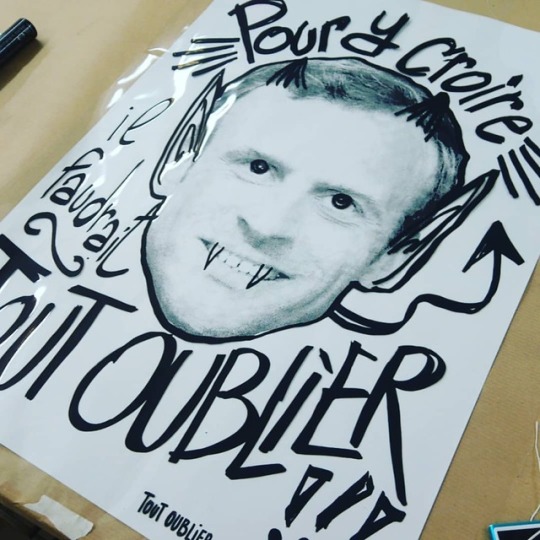
POP'LITICS, quand la pop devient politique 🤜 #newproject #sérigraphie #printmaker #print #coolwork #liège #luik #belgium #belgianartist #politique #macron #workinprogress #wip #print #intervention #contemporaryart @nextgenerationplease @bozarbrussels (à Académie Royale des Beaux-Arts de Liège) https://www.instagram.com/p/BtkuqBsFzxn/?utm_source=ig_tumblr_share&igshid=mi8ef81y5dxo
#newproject#sérigraphie#printmaker#print#coolwork#liège#luik#belgium#belgianartist#politique#macron#workinprogress#wip#intervention#contemporaryart
1 note
·
View note
Video
Le dégraissage c'est tout un art 💦#screenprinting #silkscreen #sérigraphie #printmaker #print #coolwork #liège #luik #belgium #belgianartist #nature #love #coolwork #flashy #liège #académie (à Académie Royale des Beaux-Arts de Liège) https://www.instagram.com/p/Brmon-SFxH0/?utm_source=ig_tumblr_share&igshid=o66zm532aheo
#screenprinting#silkscreen#sérigraphie#printmaker#print#coolwork#liège#luik#belgium#belgianartist#nature#love#flashy#académie
2 notes
·
View notes
Video
Et on accroche 🙊 #art #artist #draw #drawing #workinprogress #wip #print #liège #luik #belgium #belgianartist #académie #beauxarts #school #schoolofart #artschool #illustrationoftheday #jury (à Académie Royale des Beaux-Arts de Liège)
#luik#académie#illustrationoftheday#belgium#artist#belgianartist#wip#schoolofart#beauxarts#drawing#workinprogress#artschool#art#jury#liège#draw#school#print
1 note
·
View note
Photo
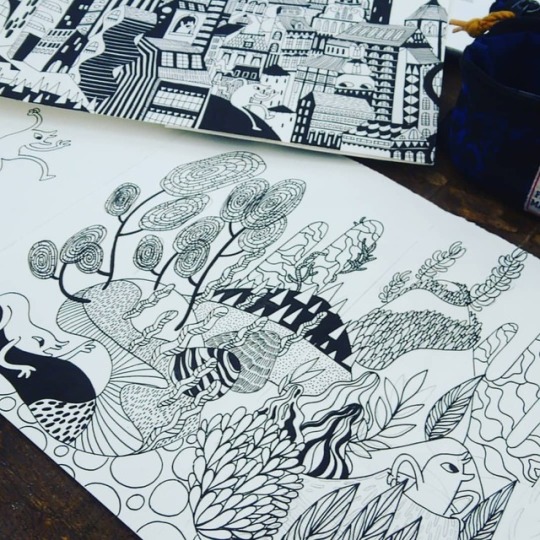
Work work work 🤖 #jo #illustratorsofinstagram #illustration #illustrator #liege #liège #luik #belgium #art #artist #draw #drawing #workinprogress #wip #illu #leporellobook (à Académie Royale des Beaux-Arts de Liège)
#liège#luik#illustrator#artist#drawing#illustration#belgium#illu#illustratorsofinstagram#workinprogress#liege#wip#jo#draw#art#leporellobook
1 note
·
View note
Photo
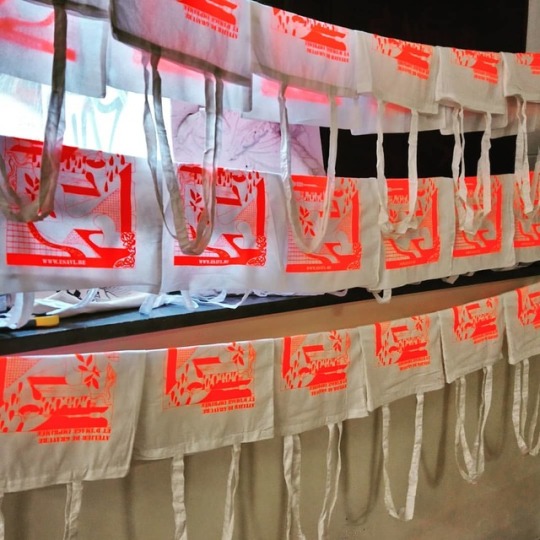
Ce week-end, j'ai sérigraphié des sacs à l'académie avec un joli visuel que j'ai réalisé pour l'atelier de gravure et d'image imprimée ! Si vous voulez des infos sur l'Académie Royale des Beaux-arts de la Ville de Liège, je vous invite à vous rendre sur le site www.esavl.be 🖌️ #art #illu #illustration #illustrationoftheday #artist #draw #drawing #screenprinting #sérigraphie #printmaker #print #coolwork #liège #luik #belgium #belgianartist #school #artschool #beauxarts (à Académie Royale des Beaux-Arts de Liège) https://www.instagram.com/p/BzEEffiIRLZ/?igshid=18hwag5qxxylw
#art#illu#illustration#illustrationoftheday#artist#draw#drawing#screenprinting#sérigraphie#printmaker#print#coolwork#liège#luik#belgium#belgianartist#school#artschool#beauxarts
0 notes
Photo
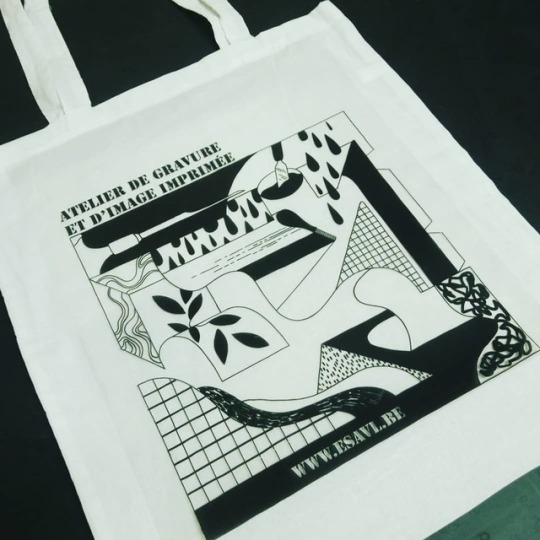
Ce week-end, on imprime des sacs de 13h à 17h à l'occasion des portes ouvertes de l'Ecole Supérieure des Arts de la Ville de Liège 🌈 venez imprimer avec nous ! #totebag #sérigraphie #printmaker #print #coolwork #expo #exhibition #portesouvertes #beauxarts #académie #illu #illustration #illustrationoftheday #art #artist #print #coolwork #flashy #sérigraphie #printmaker (à Académie Royale des Beaux-Arts de Liège) https://www.instagram.com/p/By5EmIUoSJO/?igshid=dia0kez60v9v
#totebag#sérigraphie#printmaker#print#coolwork#expo#exhibition#portesouvertes#beauxarts#académie#illu#illustration#illustrationoftheday#art#artist#flashy
0 notes
Photo

Nouvelle installation de mon travail POP'LITICS dans le couloir de l'atelier gravure/image imprimée de L'ESAVL ! Visible ce week-end à l'occasion des portes ouvertes 🌿 #illu #illustration #illustrationoftheday #art #artist #draw #drawing #workinprogress #wip #print #liège #luik #belgium #belgianartist #sérigraphie #printmaker #print #coolwork #screenprinting #printmaker #poplitics #jo #jojofromtheblock #nextgenerationplease #intervention #installation #artcontemporain #contemporaryart #kimkyujong #red #blackandwhite (à Académie Royale des Beaux-Arts de Liège) https://www.instagram.com/p/By4_PqoIy2F/?igshid=1s6x29bi1l2lj
#illu#illustration#illustrationoftheday#art#artist#draw#drawing#workinprogress#wip#print#liège#luik#belgium#belgianartist#sérigraphie#printmaker#coolwork#screenprinting#poplitics#jo#jojofromtheblock#nextgenerationplease#intervention#installation#artcontemporain#contemporaryart#kimkyujong#red#blackandwhite
0 notes
Photo

Ce matin, j'ai eu le plaisir de donner un workshop de sérigraphie aux élèves de deuxième bachelier illustration de l'Ecole Supérieure des Arts de la Ville de Liège ! Malgré une émulsion tenace, on y sera arrivé 💪🎉 great job ! #aca #school #artschool #illu #illustration #illustrationoftheday #art #artist #draw #drawing #workinprogress #wip #print #printmaker #screenprinting #sérigraphie #liège #luik #belgium #belgianartist #workshop #contemporaryart #contemporaryart #fluo #poster (à Académie Royale des Beaux-Arts de Liège) https://www.instagram.com/p/By2jAjSIPc2/?igshid=h3yjcm6bp481
#aca#school#artschool#illu#illustration#illustrationoftheday#art#artist#draw#drawing#workinprogress#wip#print#printmaker#screenprinting#sérigraphie#liège#luik#belgium#belgianartist#workshop#contemporaryart#fluo#poster
0 notes
Photo
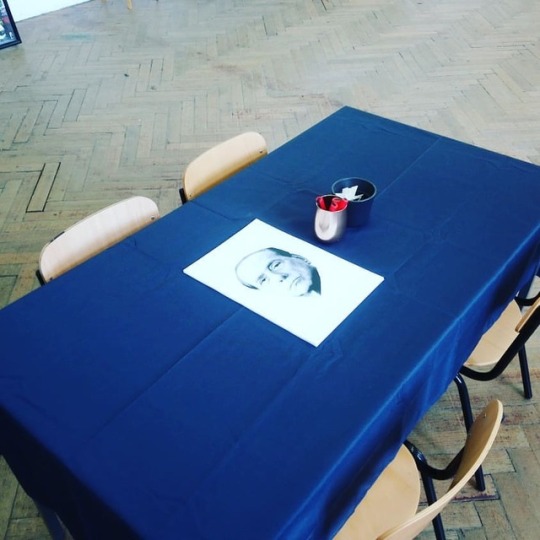
Les jeux sont faits 🎲 #jury #beauxarts #school #artschool #illu #illustration #illustrationoftheday #art #artist #draw #drawing #screenprinting #sérigraphie #printmaker #print #coolwork #liège #luik #belgium #belgianartist #passion #determination #rigueur #travail #contemporaryart #jo #jojofromtheblock #académie (à Académie Royale des Beaux-Arts de Liège) https://www.instagram.com/p/BynFOvUogRw/?igshid=1n8ohjr7j4977
#jury#beauxarts#school#artschool#illu#illustration#illustrationoftheday#art#artist#draw#drawing#screenprinting#sérigraphie#printmaker#print#coolwork#liège#luik#belgium#belgianartist#passion#determination#rigueur#travail#contemporaryart#jo#jojofromtheblock#académie
0 notes
Photo
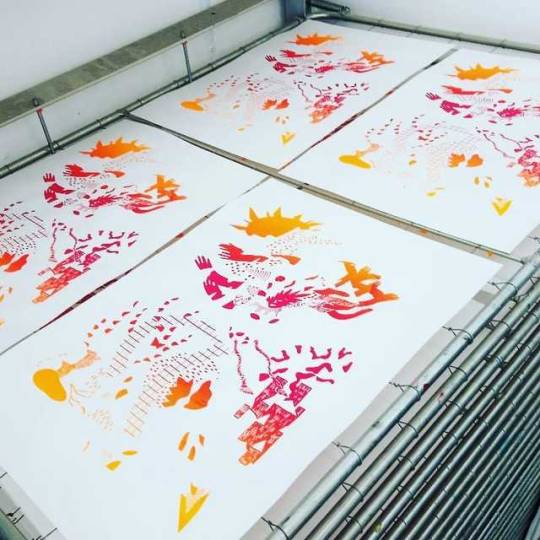
Hop un ch'ti dégradé au calme ✨ #screenprinting #sérigraphie #printmaker #print #coolwork #liège #luik #belgium #screenprintersofinstagram #printersofinstagram #printmakers #degradé #red #orange (à Académie Royale des Beaux-Arts de Liège) https://www.instagram.com/p/ByC1j-HoY5A/?igshid=i185aifbd2oa
#screenprinting#sérigraphie#printmaker#print#coolwork#liège#luik#belgium#screenprintersofinstagram#printersofinstagram#printmakers#degradé#red#orange
0 notes